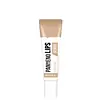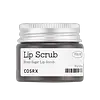What's inside
What's inside
 Key Ingredients
Key Ingredients

No key ingredients
 Benefits
Benefits

 Concerns
Concerns

 Ingredients Side-by-side
Ingredients Side-by-side

Water
Skin ConditioningJuglans Regia Shell Powder
AbrasiveCaprylic/Capric Triglyceride
MaskingGlycerin
HumectantRicinus Communis Seed Oil
MaskingPanthenol
Skin ConditioningCetearyl Alcohol
EmollientCetyl Ethylhexanoate
EmollientGlyceryl Stearate
EmollientPolyglyceryl-3 Methylglucose Distearate
EmulsifyingBeeswax
Emulsion StabilisingButyrospermum Parkii Butter
Skin ConditioningSorbitol
HumectantGlucose
HumectantCetearyl Olivate
Sorbitan Olivate
Emulsifying1,2-Hexanediol
Skin ConditioningPalmitic Acid
EmollientHydrogenated Castor Oil
EmollientHydroxyacetophenone
AntioxidantStearic Acid
CleansingParfum
MaskingArginine
MaskingCaprylyl Glycol
EmollientCarbomer
Emulsion StabilisingCopernicia Cerifera Wax
Sodium Polyacrylate
AbsorbentEthylhexylglycerin
Skin ConditioningHydrogenated Polydecene
EmollientTocopherol
AntioxidantDipotassium Glycyrrhizate
HumectantDisodium EDTA
Trideceth-6
EmulsifyingSimmondsia Chinensis Seed Oil
EmollientPrunus Amygdalus Dulcis Oil
Skin ConditioningLauric Acid
CleansingMyristic Acid
CleansingButylene Glycol
HumectantSodium Hyaluronate
HumectantPrunus Armeniaca Fruit Extract
Skin ConditioningHoney Extract
HumectantWater, Juglans Regia Shell Powder, Caprylic/Capric Triglyceride, Glycerin, Ricinus Communis Seed Oil, Panthenol, Cetearyl Alcohol, Cetyl Ethylhexanoate, Glyceryl Stearate, Polyglyceryl-3 Methylglucose Distearate, Beeswax, Butyrospermum Parkii Butter, Sorbitol, Glucose, Cetearyl Olivate, Sorbitan Olivate, 1,2-Hexanediol, Palmitic Acid, Hydrogenated Castor Oil, Hydroxyacetophenone, Stearic Acid, Parfum, Arginine, Caprylyl Glycol, Carbomer, Copernicia Cerifera Wax, Sodium Polyacrylate, Ethylhexylglycerin, Hydrogenated Polydecene, Tocopherol, Dipotassium Glycyrrhizate, Disodium EDTA, Trideceth-6, Simmondsia Chinensis Seed Oil, Prunus Amygdalus Dulcis Oil, Lauric Acid, Myristic Acid, Butylene Glycol, Sodium Hyaluronate, Prunus Armeniaca Fruit Extract, Honey Extract
Sucrose
HumectantCaprylic/Capric Triglyceride
MaskingGlycerin
HumectantEuphorbia Cerifera Wax
Sorbeth-30 Tetraoleate
EmulsifyingButyrospermum Parkii Butter
Skin ConditioningBis-Diglyceryl Polyacyladipate-2
EmollientWater
Skin ConditioningStearalkonium Hectorite
Gel Forming1,2-Hexanediol
Skin ConditioningPropylene Carbonate
SolventTheobroma Cacao Extract
Skin ConditioningEthylhexylglycerin
Skin ConditioningButylene Glycol
HumectantSaccharum Officinarum Extract
MoisturisingDextrin
AbsorbentCitrus Limon Fruit Extract
MaskingHoney
HumectantSucrose, Caprylic/Capric Triglyceride, Glycerin, Euphorbia Cerifera Wax, Sorbeth-30 Tetraoleate, Butyrospermum Parkii Butter, Bis-Diglyceryl Polyacyladipate-2, Water, Stearalkonium Hectorite, 1,2-Hexanediol, Propylene Carbonate, Theobroma Cacao Extract, Ethylhexylglycerin, Butylene Glycol, Saccharum Officinarum Extract, Dextrin, Citrus Limon Fruit Extract, Honey
 Reviews
Reviews

Ingredients Explained
These ingredients are found in both products.
Ingredients higher up in an ingredient list are typically present in a larger amount.
1,2-Hexanediol is a synthetic liquid and another multi-functional powerhouse.
It is a:
- Humectant, drawing moisture into the skin
- Emollient, helping to soften skin
- Solvent, dispersing and stabilizing formulas
- Preservative booster, enhancing the antimicrobial activity of other preservatives
Butylene Glycol (or BG) is used within cosmetic products for a few different reasons:
Overall, Butylene Glycol is a safe and well-rounded ingredient that works well with other ingredients.
Though this ingredient works well with most skin types, some people with sensitive skin may experience a reaction such as allergic rashes, closed comedones, or itchiness.
Learn more about Butylene GlycolThis ingredient is also known as shea butter. It is an effective skin hydrator and emollient.
Emollients help soothe and soften your skin. It does this by creating a protective film on your skin. This barrier helps trap moisture and keeps your skin hydrated. Emollients may be effective at treating dry or itchy skin.
Shea butter is rich in antioxidants. Antioxidants help fight free-radicals, or molecules that may harm the body. It is also full of fatty acids including stearic acid and linoleic acid. These acids help replenish the skin and keep skin moisturized.
While Shea Butter has an SPF rating of about 3-4, it is not a sunscreen replacement.
Shea butter may not be fungal acne safe. We recommend speaking with a professional if you have any concerns.
Learn more about Butyrospermum Parkii ButterThis ingredient is an emollient, solvent, and texture enhancer. It is considered a skin-softener by helping the skin prevent moisture loss.
It helps thicken a product's formula and makes it easier to spread by dissolving clumping compounds.
Caprylic Triglyceride is made by combining glycerin with coconut oil, forming a clear liquid.
While there is an assumption Caprylic Triglyceride can clog pores due to it being derived from coconut oil, there is no research supporting this.
Learn more about Caprylic/Capric TriglycerideEthylhexylglycerin (we can't pronounce this either) is commonly used as a preservative and skin softener. It is derived from glyceryl.
You might see Ethylhexylglycerin often paired with other preservatives such as phenoxyethanol. Ethylhexylglycerin has been found to increase the effectiveness of these other preservatives.
Glycerin is already naturally found in your skin. It helps moisturize and protect your skin.
A study from 2016 found glycerin to be more effective as a humectant than AHAs and hyaluronic acid.
As a humectant, it helps the skin stay hydrated by pulling moisture to your skin. The low molecular weight of glycerin allows it to pull moisture into the deeper layers of your skin.
Hydrated skin improves your skin barrier; Your skin barrier helps protect against irritants and bacteria.
Glycerin has also been found to have antimicrobial and antiviral properties. Due to these properties, glycerin is often used in wound and burn treatments.
In cosmetics, glycerin is usually derived from plants such as soybean or palm. However, it can also be sourced from animals, such as tallow or animal fat.
This ingredient is organic, colorless, odorless, and non-toxic.
Glycerin is the name for this ingredient in American English. British English uses Glycerol/Glycerine.
Learn more about GlycerinWater. It's the most common cosmetic ingredient of all. You'll usually see it at the top of ingredient lists, meaning that it makes up the largest part of the product.
So why is it so popular? Water most often acts as a solvent - this means that it helps dissolve other ingredients into the formulation.
You'll also recognize water as that liquid we all need to stay alive. If you see this, drink a glass of water. Stay hydrated!
Learn more about Water